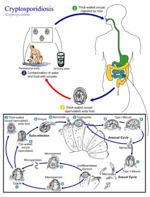Cryptosporidium
Jump to navigation
Jump to search
| This article is still under construction. |
|
|
Recognition
- Minute protozoan parasite
- Wide host range
- Parasitises epithelial cells lining the epithelial cells lining the ailimentary and respiratory tracts
- Developmental stages confined to the microvillous brish border
- C. parvum most associated with disease in domestic animals and in humans
- Other species affect birds
- Small oocysts of 4-5μm
Life Cycle
- Direct life cycle
- Only one host
- Homoxenous
- 1 week prepatent period
- Sporulated oocysts past in faeces
- Autoinfection can occur
- Thin walled oocysts
- Faecal-oral transmission also occurs
- Thick walled oocysts
Pathogenesis
- Causes outbreaks of diarrhoea in young animals
- Common cause of calf-hood scours
- Older animals may be asymptomatic carriers
- Contributes to undifferentiated neonatal calf diarrhoea which is a mixed viral enteritis in calves
- Common infection in AIDS patients
Epidemiology
- Direct faecal-oral infection
- E.g. School parties visiting farms
- Water-bourne infection
- E.g. contaminated water supply may infect hundreds of people
- Difficult to locate source
Diagnosis
- Faecal smear
- Ziehl-Neelson (ZN) stain
- Oocysts stain red against a blue/green background
- Immunoassays
- Detect oocysts in faeces
Control
- Isolate/quarantine brought-in calves
- Treat if signs of diarrhoea present
- Good hygiene, adequate bedding, disinfection of calf pens is important
- Prevention/treatment
- Halofuginone
- Halocur or Intervet
- Oral dosage
- Halofuginone
